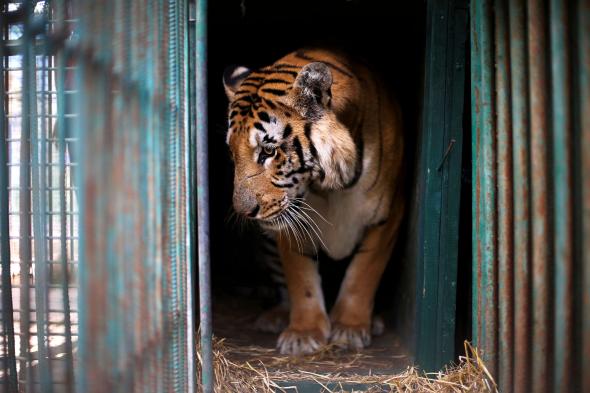Animals Rescued From the ‘World’s Worst Zoo’

When a rescue team arrived to evacuate a closing zoo near the Gaza Strip city of Khan Younis in late August, just 15 animals remained. They included Laziz, a nine-year-old Bengal tiger that is—according to Four Paws, the Vienna-based animal-welfare nonprofit that led the rescue—the last tiger in Gaza. There were also five monkeys, an emu, a pelican, two buzzards, two porcupines, two tortoises, and a doe. The doe had lost her fawn to wounds shortly before the rescuers arrived. Opened in 2007 on three and a half acres of land next to an amusement park, the Khan Younis Zoo has been called “the world’s worst zoo” by Four Paws and international media outlets. Hundreds of animals here starved to death during a seven-week war between Israel and Hamas in 2014. And last year, the surviving animals began sharing their cramped cages with the dead: Over 50 dead animals—including Laziz’s mate—were taxidermied by the zoo staff. Abu Diab Oweida, the Palestinian businessman who owned the zoo, said that the mummifications were politically motivated—done “to prove to the whole world that even animals have been affected and [killed] by the Israeli occupation after the three [recent] wars in the Gaza Strip.”
How It Happened
Four Paws and its director of emergency response, Amir Khalil, had sought for months to close the zoo and transfer the animals to sanctuaries. In late August, the ambitious rescue plan became reality. “The idea to close [the zoo came in] April of last year,” said Khalil, an Egyptian-born veterinarian who lives in Austria. “It was a concept last September. It was a plan this April. It was a mission in August.” Khalil needed to negotiate with four people: Oweida and three of his sons. In May they agreed on the concept of evacuating the zoo. “The Israeli occupation of Gaza,” says Oweida, “ended everything. They smashed and destroyed what [was] inside the Gaza Strip. So I decided to donate the animals to save what remained of [them], to live safely inside a nature reserve and in peace and security.” The rescue itself was complicated, “a complex coordination between Israeli, Palestinian, and international officials,” according to a spokesperson at the Israeli Coordinator of Government Activities in the Territories, a branch of the Ministry of Defense that liaises with the Palestinian population in the Gaza Strip and West Bank, and with international organizations working in both territories. “[The rescue] was not easy,” Khalil said. “To be neutral is not easy. I think Four Paws was a form of mediator between three, four countries”—Israel, Jordan, and the Palestinian governments of Hamas and Fatah.
Read More: http://news.nationalgeographic.com/2016/09/saving-animals-gaza-strip-khan-younis-zoo/

